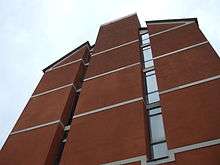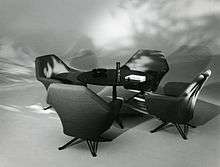Ignazio Gardella
Ignazio Gardella (30 March 1905 in Milan, Lombardy – 16 March 1999) was an Italian architect and designer.

Biography
Born into a family of architects, the first of whom was his namesake Ignazio Gardella (senior), he graduated in engineering from the Politecnico di Milano university in 1928 (while he received his degree in architecture from the IUAV in 1949).
.jpg)
In his university years he came into contact with other young protagonists of the Milanese scene together with whom he took part in the creation of the Italian Modern Movement.
Professional activity
His long professional activity, which began before his graduation at the end of the 1920s with his father Arnaldo Gardella, produced an enormous quantity of projects and realizations.
The CIAM
In the same years he was a leader of important cultural events, like CIAM (in 1952 he founded, with others, the summer session in Venice; in 1959 he participated in CIAM X in Otterlo in the Netherlands), or the first INU conferences (starting in 1949).
International maestro

The figure of Gardella remained at the pinnacle of Italian architecture for all of the 1960s and '70s, with intense professional activity whose importance is proven by his presence in international publications. In the last phase of his life, Gardella, now among the eminences grises of Italian architecture, still produced significant projects, like the Faculty of Architecture of Genoa (1975–1989), which brought him once more to the front lines of the architectural debate.
The designer activity

Gardella's activity has had a determining role in the field of design as well, starting as early as 1947, when he founded the Azucena Agency with Luigi Caccia Dominioni, the first that inaugurated Italian design production of high quality. Gardella designed primarily decorative furniture objects.
Architecture according to Gardella
If one looks for Ignazio Gardella's style, one is likely to be disoriented. His projects, over the years, changed according to changing architectural tendencies, often anticipating them, but always containing elements that diverged from the current with which they might be associated. Gardella is one of the Italian Rationalists, but his use of local construction techniques, like the famous brick screen of the Dispensario in Alessandria, makes him in some ways a heretic.
In the 1950s he came closer to regionalist currents, but his buildings also maintained an abstraction that distanced them from the most famous works of Neoliberty or Neorealism.
In the 1960s and 1970s he seemed to adhere to a strictly professional form of practice like the Modern Movement or the International Style. His Uffici Alfa Romeo (1969) opposed the use of industrial materials and the development of a complex program. But Gardella strictly controlled the form, imposing a symmetrical composition.
In the 1980s he seemed to stick to the Post Modern, but he did not in reality share its principles. Thus he himself said, "It is always difficult to say who are the fathers and who the sons. But Mario Ridolfi and I said, jokingly, that if we were really the fathers of all the works exhibited (at the 1980 Venice Biennale) we would have to admit (...) to having gone to bed with women of every type and every race." (s. Guidarini, 2002).
In reality there are aspects of his work that remain the same throughout his long career and constitute a continuity. These aspects can be synthesized in two complementary points:
- Gardella's architecture always maintains a composure that could be called 'classic'. This can be deduced from the extreme refinement of his details, which are comparable to those of his contemporary and friend Franco Albini, whether by control of the complete design of a building or because of the design of architectural spaces. In his architecture there is a preoccupation with and emphasis on the immediate, on the style of the moment, and a research for a kind of timelessness.
- Complementing this aspect is his capacity to change registers, to adapt himself to the genius loci (the spirit of a place), as few other architects have succeeded to do. If the almost contemporary Case Borsalino in Alessandria are compared with the Casa alle Zattere in Venice, one realizes that there is a great difference. The materials have changed, as have the decorative elements and the conception of volume. This is clearly owed to his will to take up influences from the built environment or context.
Works and important projects
_-_BEIC_6354245.jpg)
From among his first buildings one could note the Antitubercular Dispensary of Alessandria (1934–38) which is one of the masterpieces of rationalist architecture.
.gif)
Before World War II
Before the war he also participated in several important architecture competitions such as:
- 1933-36 Extension of the Villa Borletti in Milan.
- 1934 Progetto di concorso per la torre littoria di Piazza del Duomo a Milan (non realizzato).
- 1934-38 Dispensario Antitubercolare di Alessandria.
- 1944 The Milano-Verde (Green Milan) Plan (with the Casabella group, including Franco Albini, Giuseppe Pagano e Giovanni Romano);
After the War
In the early postwar period, Gardella took up once more his activity with full vigor, producing many important works and some masterpieces such as:
- 1944-47 Casa del Viticultore
- 1947-54 Padiglione d'Arte Contemporanea in Milan (PAC) (which he rebuilt himself – with his son Jacopo Gardella - in 1996 after the attack of 1993).
- 1947-54 Casa Tognella [Casa al Parco] in Milan.
- 1951-54 INA-Casa a Cesate, Milan. With BBPR, Franco Albini and Gianni Albricci.
- 1952 Case ''Borsalino'' in Alessandria.
- 1953-58 Casa alle Zattere in Venice
- 1955 “Giardini d’Ercole”, residential building, Via Marchiondi in Milan, with Anna Castelli Ferrieri.
- 1958 Mensa Olivetti in Ivrea.
- 1967 Kartell headquarters in Noviglio, with Anna Castelli Ferrieri.
- 1969 Uffici Alfa Romeo in Arese, with Anna Castelli Ferrieri.
- 1969 Project for the theater of Vicenza (not realized).
- 1969-75 Piano particolareggiato for the area of San Donato and San Silvestro in Genoa (partially carried out with Silvano Larini, Jacopo Gardella, Daniele Vitale, Giuliano Nardi) .
- 1975-89 Faculty of Architecture of Genoa.
- 1981-90 Teatro Carlo Felice in Genoa (with Aldo Rossi, Bruno Reichlin and Angelo Sibilla).
Writings
The publications of Gardella, though they include many articles and projects published in all of the major international reviews, are not just of theoretical interest. A list of his publications is available at:
- Interview with Ignazio Gardella by Antonio Monestiroli, in L'architettura secondo Gardella, Bari-Roma, Laterza,1997.
University professor
Gardella also had an important role in education, from his invitation in 1949 by Giuseppe Samonà to be part of the staff of the IUAV. His academic career brought him to the post of Professore Ordinario in 1962, which he held until 1975.
Awards
He won many prizes, among which are the: Premio Nazionale of Olivetti for Architecture (1955), the 1977 Medaglia d'oro del Presidente della Repubblica ai benemeriti della Scuola, della Cultura e dell'Arte (Gold Medal, the Leone d'Oro alla carriera dalla Biennale di Venezia (1996), Honorary membership in RIBA (Royal Institute of British Architects), and member of the Accademia di San Luca and socio onorario of the Accademia di Belle Arti di Brera.
Bibliography
- Ceriani, AA. VV. a cura di Franco Buzzi; Ignazio Gardella progetti e architetture 1933-1990, Venezia, Marsilio, 1992.
- Guidarini, Stefano; Ignazio Gardella nell'architettura italiana. Opere 1929-1999, Milan, Skira, 2002.
- Loi, AA. VV. a cura di Maria Cristina; Ignazio Gardella. Architetture, Electa, Milan 1998.
- Porta, AA. VV. a cura di Marco; L'architettura di Ignazio Gardella, presentazione di Giulio Carlo Argan; saggio introduttivo di Roberto Gabetti; testimonianze di Franco Purini, ... (e altri), Milan, Etas libri, 1985.
- Samonà, Alberto; Ignazio Gardella e il professionismo italiano, Romae Officina, 1981c.
- Zermani, Paolo; Ignazio Gardella, Rome-Bari, Laterza, 1991,